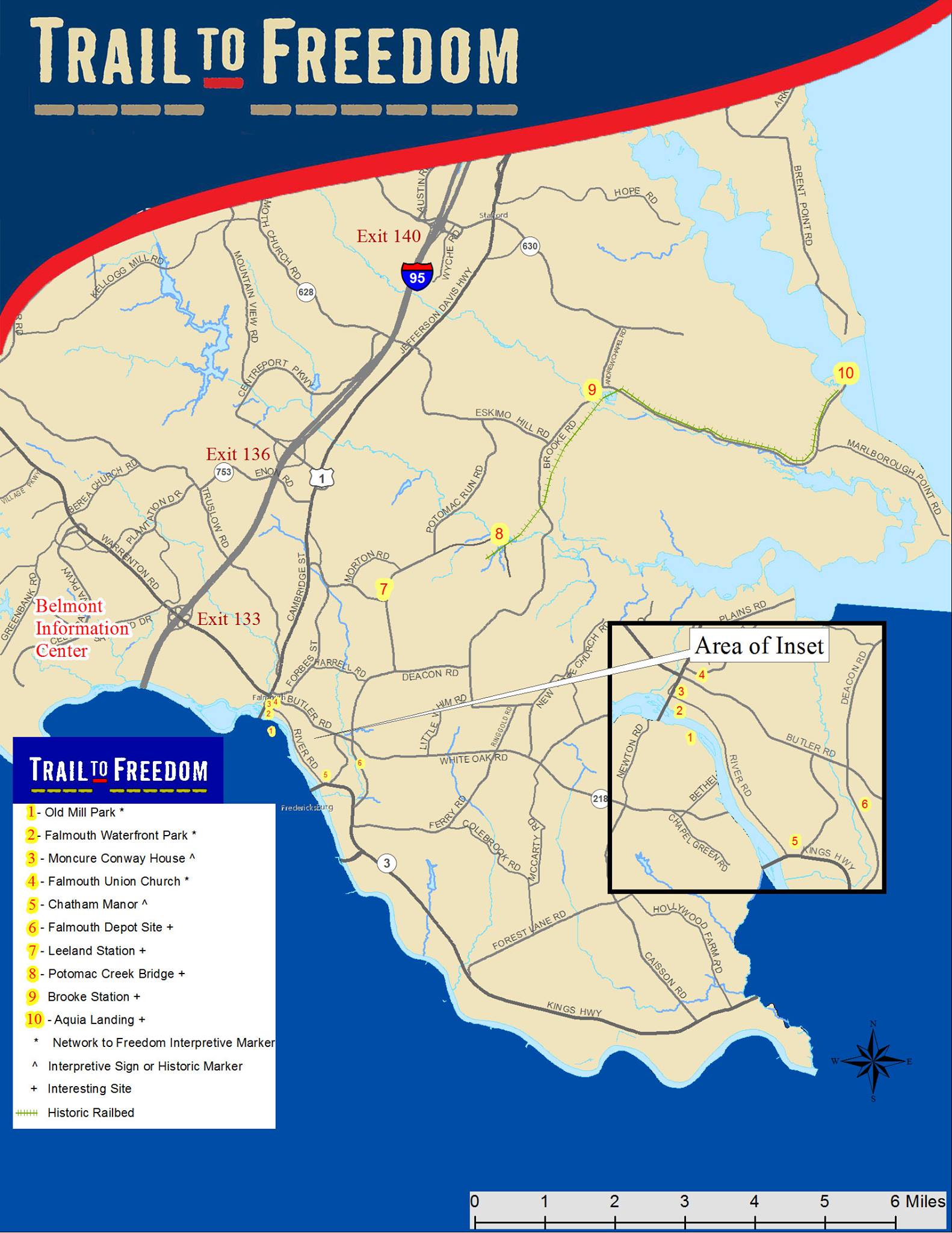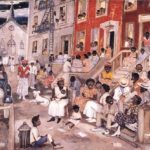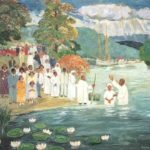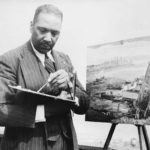Black History and African American Heritage in Stafford
Visit the region’s rich African-American Landmarks and learn about Black History in Stafford.
Discover (or rediscover!) Stafford County’s rich Black History and African American Heritage.
When you follow the roots of history, you’ll uncover the birthplace of leadership, discover the depths of perseverance, understand the definition of heroism, and find hidden gems in unexpected places.
The history of Stafford County cannot be segmented by color, creed, or ethnicity. Stafford’s history consists of the earliest peoples—the Patawomeck Indians, the earliest Europeans arriving by choice, and Africans brought here in bondage. All who populated Stafford contribute to the fabric that weaves the history of this place together.
“…before there was a town, there was a river, a valley, and the falls…The region was only populated by native people. Then, in 1608, white men came by boat and set up crosses of wood and brass and cut their names upon trees to signify possession had been taken by English authority. Under this authority appeared a people of black skin taken from another continent and brought to this place without their consent. So began the African American history of Falmouth (Stafford), Virginia.” -Virginia Shade
Visit the Places
Discover the Stories
There are many places that teach us about the struggles, strengths, and victories of African Americans in Stafford County.
Aquia Landing
2846 Brooke Rd., Stafford, VA 22554
This is where the steamboats and railroads met and the landing played a major role in transportation prior to a reliable road network. Some enslaved people escaped to freedom via this gateway. More than 10,000 enslaved people found freedom through Aquia Landing, including Henry “Box” Brown; Solomon Northup (12 Years a Slave); William and Ellen Craft, a married couple who disguised themselves as slave and master to escape bondage; and John Washington (A Slave No More). Aquia Landing now presents a scenic view on the banks of Aquia Creek with pavilions for rent and interpretive Trail to Freedom signs. It is also an Underground Railroad Network to Freedom Site.
540-658-5019 | TourStaffordVA.com
1739 Richmond Hwy., Stafford, VA 22554
Originally built in 1939 by the Public Works Administration (PWA) as the Stafford Training School (a term used in the South to differentiate a White high school from a Black high school). It was the only place where Black students could receive an education beyond the 7th grade. This building, now listed with the National Register of Historic Places and as a Virginia Landmark, is open for visitors from Mon.-Fri. 8:00 a.m. – 4:30 p.m.
540-658-4017 | TourStaffordVA.com
Historic Port of Falmouth
401 River Rd., Falmouth, VA 22405
A historic site with layers of history. One little known but important story was the self-emancipation of more than 10,000 enslaved people. When Union Forces occupied Falmouth during the Civil War, the area’s White population fled. Beginning in April of 1862 thousands of enslaved people crossed the Rappahannock River from Fredericksburg to Falmouth, heading to freedom. John Washington crossed here and kept a diary of his journey to freedom. Excerpts of this poignant and powerful diary can be found on the Trail to Freedom’s website.
540-658-5373 | TrailToFreedomVA.com
120 Chatham Lane, Fredericksburg, VA 22405
This National Park Service site interprets centuries of history from the colonial period through years after the Civil War.
540-693-3200 x2 |NPS.gov
201 Carter St., Falmouth, VA 22405
Here John Washington observed a funeral of several Union Soldiers and recorded his recollection of the “sad duty to perform” connecting their sacrifices with the potential freedom for those held in bondage.
540-368-0464 | FalmouthUnionChurch.org
Colonial Times, The Revolutionary War, and the Federal Period
The first Africans who arrived in the Virginia colony in 1619 came as indentured servants. Soon thereafter, their status was only as slaves. In the late 1600s enslaved people were brought into the sparsely settled Rappahannock Valley, primarily to serve as agricultural laborers. Many were forced to work on larger farms or plantations such as Chatham. Human cargo from newly arrived slave ships disembarked in Falmouth and slave auctions could be held anywhere a crowd might gather. Hundreds of enslaved people were forced to work on farms and docks, at stone quarries, and in Falmouth’s thriving mills and iron works.
A noteworthy exception was John DeBaptiste, a prominent Black citizen who served on board a ship commissioned by George Washington during the Revolutionary War. DeBaptiste was a free Black and operated the ferry at Falmouth. He owned a good deal of property in Fredericksburg and is buried in the Falmouth Cemetery.
By 1810, Stafford County had a population of about 4,200 enslaved Blacks, 350 free Blacks, and 5,400 Whites. Stafford was the stage for a rebellion that preceded the famous Nat Turner Rebellion in Southampton County, Virginia by a quarter of a century. Early in January 1805, slaves owned by William Fitzhugh of Chatham refused to return to their jobs after the Christmas holiday. When ordered back to work by the overseer, they severely whipped him. The revolt’s ringleader was later discovered, shot, and killed.
During the 1800s, slaves were valued as investments as well as workers. A Stafford resident wrote a friend about the prices of slaves in 1839 saying, “Negros are selling higher at a time than I have ever seen them. Best Men 1440 to 1500. Best field Girls 1300 to 1350” (They Called Stafford Home by Jerrilyn Eby).
Antebellum Period and the Civil War
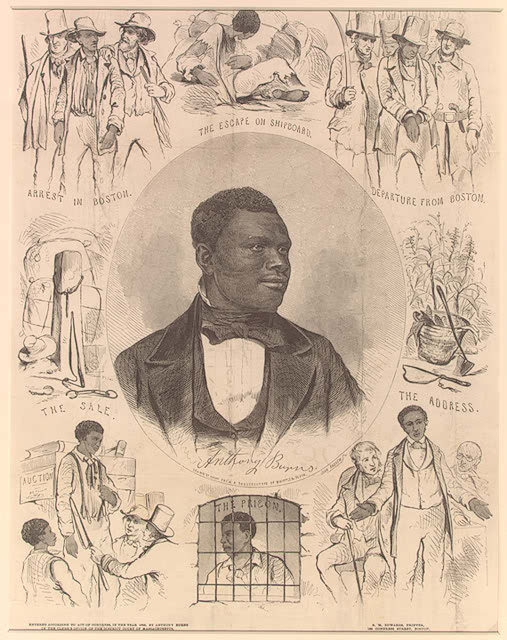
Anthony Burns
One of the most important cases to test the Fugitive Slave Law of 1850 involved a runaway slave from Stafford. Anthony Burns escaped by ship and was captured and tried in Boston. Over 50,000 outraged Bostonians rallied in the streets to support a Black man they considered to have been kidnapped. Burns was returned to Virginia, he was later purchased by an abolitionist minister for the sum of $1,300 and set free. Burns became a minister in Canada. Anthony Burns Elementary School is named in his honor.
Many freedom seekers traveled at night, often covering hundreds of miles on foot. Enslaved people also sought passage to the north via the RF&P Railroad. The train met the steamboats at Aquia Landing. While most of these stories are unknown, the daring escapes of William and Ellen Craft and Henry “Box” Brown are remarkable and documented.
In 1849, the Crafts, a husband and wife, were slaves in Georgia. Because she was light of skin, she disguised herself as an old, sick gentleman and her husband portrayed her “man servant” who cared for “him” on “his” travels. They passed through Aquia Landing on their way north. In 1849 Henry “Box” Brown mailed himself to freedom in a wooden box. He endured wagon, railroad, steamboat, and ferry rides, almost expiring when his box turned upside down while sitting on the dock at Aquia Landing.

Moncure Conway, Abolitionist
Although no major battles took place in Stafford, both Confederate and Union troops occupied the county in intervals from 1861 to 1865. When Union forces appeared in Stafford County in the spring of 1862, their presence enabled more than 10,000 self-emancipating freedom seekers to bravely cross the Rappahannock River, travel through Stafford to Aquia Landing, and then on to contraband camps in Washington, D.C. The story of these thousands is personified through the memoirs of John Washington. One of the few people in bondage who could read or write, he scribed a very moving account of his flight to freedom in “A Slave No More.” The Aquia Landing was also a stop for kidnapped free Blacks like Solomon Northup. Northup’s life is documented is his book, “12 Years a Slave.” He traveled to bondage in 1841 and back to freedom in 1853, both times to passing through Aquia Landing.
A rare local voice against slavery was that of Moncure Conway of Falmouth. Conway attended Dickinson College and Harvard Divinity School. He became friends with prominent intellectuals of the period, including Ralph Waldo Emerson, and became a noted author in his own right. Conway also shared his views on abolition with President Lincoln. In the spring of 1862, Moncure Conway helped 31 of his own family’s slaves escape to freedom from Falmouth to Yellow Springs, Ohio. Some descendants still live there today.
Reconstruction, Education, and Civil Rights
After the Civil War, Stafford suffered terribly from the former occupation of more than 140,000 Union troops. The African American population decreased by 60 percent. Those who remained continued to work in many of the same occupations that they had prior to the war. They could now keep what they earned and many had their own small farms and businesses.
During this period, several Black churches were organized in Stafford, initially in homes or even outdoors in brush arbors. Churches were important to the Black community, not only for religious services but also as gathering places for civic, social, and civil rights meetings.
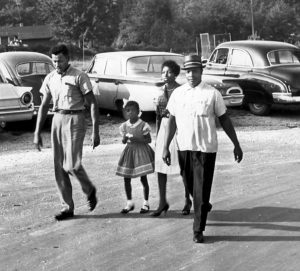
Cynthia Montague enrolling in third grade at Stafford Elementary
By the 1870s, Stafford had its first two Black schools with a total of 99 students; both had White teachers.
By 1883, there were eight one-room schools for Blacks, some of which had Black teachers; by 1904, all of Stafford’s Black schools were taught by Black instructors. Some notable Black educators were E.H. Johnn and Lizzie Dishman (1880s), Rev. Albert Ray (1890s), Jason Grant (1890s), F.E. and Robinette Cunningham (1900s), Annie Morton (1920s), Addie and Henry Harrison Poole (1930s- 1950s), and Edward Smith (1950s). H.H. Poole was appointed supervisor of Black schools in Stafford and King George Counties.
The Stafford school system started the integration process in September 1961, seven years after the Brown v. Board of Education Supreme Court decision. Doretha and Cynthia Montague were the first Black students to attend the all-White Stafford Elementary School. Total integration of Stafford schools took place in 1964.
One famous Staffordian, Palmer Hayden, born Peyton Cole Hedgeman in Widewater, became a renown Harlem Renaissance painter. He depicted everyday life, folklore, and Black historical events. Most of his works are now displayed at the Museum of African American Art in Los Angeles, California. Hayden’s work appears as the cover of his brochure.
Palmer Hayden, a Harlem Renaissance painter who was born in Widewater
Palmer C. Hayden was born on January 15, 1890 in Widewater, VA and in his lifetime became a prominent painter of the Harlem Renaissance. Much of his artwork depicted African American life and culture, landscapes, and seascapes. Though he travelled the world in his adult life
His birth name was Peyton Cole Hedgeman, the fifth of ten children born to James “Jim Hedge” Hedgeman and Nannie Belle Cole. His father was born enslaved to W.E. Moncure in 1856 and both Jim and Nannie worked for the Waller family. Jim Hedge managed the Clifton farm and fishery while Nannie helped with the laundry at Richland. Both Clifton and Richland were homes owned or lived in by members of the Waller family in Widewater.
Early in his childhood, Hayden was introduced to drawing by an older brother, however, his early ambition was to be a fiddle player. This early love of music and dream to be a musician does make an appearance is his later artwork, most notably in his painting Midnight at the Crossroads. In his teenage years, Hayden moved to Washington D.C. to find employment. His father and brother Eddie continued to work at Clifton fishery. Hayden worked odd jobs though the city, bouncing from occupation to occupation before deciding to enlist in the Army in 1912. It was during this time that he had his first experience with artistic education and re-enlisted in 1916. He was then stationed at West Point, where Hayden started a correspondence drawing course to explore art further.
After his time in the Army, Hayden began travelling to further his art career. He worked various jobs in New York City, which was where he became involved with the Harlem Renaissance. Hayden pursued his career by attending courses at Columbia University and studied under art instructor Victor Perard at the Cooper Union. His life in New York was difficult, but much of his later art depicting African American life drew upon his experiences during that time. In 1926, Hayden received an award and funding from the Harmon Foundation to travel to Paris and expand his studies and career.
During this time, Hayden’s work depicted primarily seascapes and landscapes. His most notable work referenced African American life, and drew inspiration from his own life and experiences as well as African cultural influences. Many of his paintings after his time in Paris are associated with the Harlem Renaissance, black urban life in the city, and show early indications of black empowerment. Some of his paintings even tie to his early life in Widewater, depicting rural life and more religious ties, a notable example being Baptizing Day.
In his older years, Hayden’s artwork drew more on folklore than his previous work. He created The John Henry series during the 1940s, which are rooted in the legendary story of John Henry, a black man who battled machine during the construction of the railroad through the Appalachian Mountains. Outside of his artwork, Hayden became involved in the Civil Rights movement, speaking out against racist policies that hindered African American and Hispanic communities. Hayden died on February 18, 1973 at the age of 83.
Preserving African American History Today
The African American community in Stafford is a vibrant and growing part of the population. The Stafford County Branch of the NAACP remains the primary civil rights organization in the county. The NAACP, National Council of Negro Women, and the Stafford County Historical Society have contributed to the preservation and dissemination of African American history through their programs and publications. Stafford Tourism has a list of sites and details on TourStaffordVA.com. An African American history mural at the Rowser Building commemorates the significant contributions made by the African American Community.

